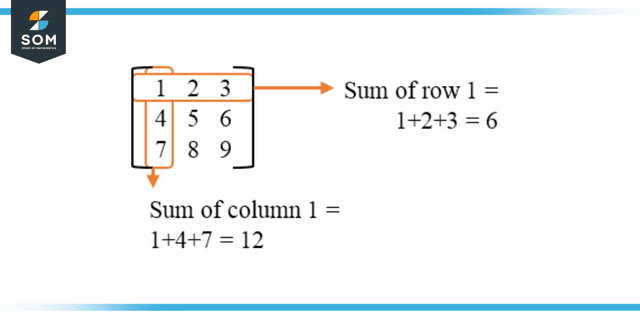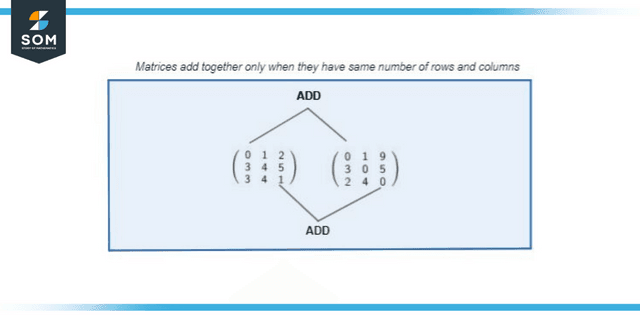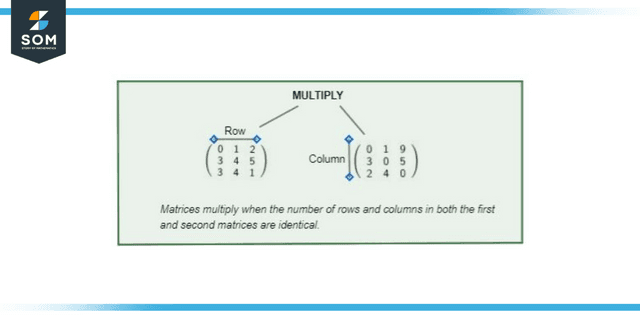JUMP TO TOPIC
Matrix|Definition & Meaning
Definition
A matrix is a two-dimensional data representation consisting of a rectangular array or column of values, symbols, or expressions organized into rows and columns. In mathematics, a matrix is typically a rectangular collection of elements. Matrices with real-valued values are called real matrices, whereas those with complex-valued entries are called complex matrices.
What Are Matrices?
The plural of “matrix” refers to the rectangular array or table in which the elements (or numbers) are organized into rows and columns. All possible combinations of columns and rows are possible. Additions, scalar multiplying, multiplication, transposition, etc., are only some of the many operations that may carry out on matrices.
You can add or subtract matrices only if their row and column counts are identical, and you can multiply matrices only if the same number of columns and rows appear in both matrices.

Figure 1: Rows and Columns of a Matrix
Notation
When a matrix has x rows and y columns, its number of elements is equal to m multiplied by n. The matrix is denoted by an uppercase letter, in this case, the letter ‘A.’ In contrast, each element in the matrix is denoted by a lowercase letter and two subscripts representing the element’s position in the number of rows and columns in the same order. In this example, the subscripts indicate an element’s position in the matrix.
Matrix Operations
Matrix problems can be solved by applying mathematical operations to the matrix, such as addition, subtraction, multiplying, etc. A matrix’s number of rows and columns is an essential factor in its calculation. When performing addition and subtraction operations, the matrix’s number of rows and columns must be identical.
On the other hand, when performing operations involving multiplication, the total number of rows in the first metric and the total number of columns in the second matrix must be identical. The following is a list of the fundamental operations that can be carried out on matrices:
- The Accumulation of Matrix
- Calculating Differences Between Matrixes
- Scalar Multiplication
- Matrices subjected to multiplication
- Transposing Matrices
Matrix Addition
Matrices can only be added together if they share the same number of rows and columns. If either of the matrices’ row or column counts differ, adding them together is impossible.

Figure 2: Addition of Matrices
Matrix Subtraction
To subtract matrices, the matrix must have the exact number of rows and columns. Otherwise, the subtraction of matrices is not possible.
Scalar Multiplication of Matrices
The process of obtaining the multiplication of a matrix A with any value ‘c,’ called scalar multiplication, involves multiplying each element of the matrix A by the number c.
Properties of Scalar Matrix
The many characteristics of matrices, which apply to the scalar multiplication of any two scalars, J and M, using matrices C and D, are as follows:
- J(C + D) = JC + JB (J + M)
- C = JC + MC
- C = J(MC) = M(JC) (-J)
- C = -(JC) = J(-C) (-C)
- 1·C= C \s(-1) (-1)
- C= -C
Multiplication of Matrices
The concept of multiplying matrices can only be specified if the number of rows and columns in both the first and second matrices are identical.

Figure 3: Multiplication of Matrices
The multiplication of matrices is related to various properties that might further come. Applying this rule to any three matrices X, Y, and Z:
- XY ≠ YX
- X(YZ) = (XY)Z
- X(Y + Z) = XY + XZ
- (X + Y)Z = XZ + YZ
Transpose of a Matrix
When we shift the rows of a matrix to the columns and the columns of a matrix to the rows, we have completed the transposition of the matrix. The transposition of matrices refers to switching the order of rows and columns within the matrix.
Determinant of Matrix
A number explicitly specified for square matrices is called the determinant of the matrix. In the process of analyzing linear equations and finding solutions to them, it is utilized. This product can be found in any row or column of the matrix. The determinant of matrix A is shown by the notation |A|.
Adjoint of a Matrix
To compute the adjoint of matrices, get the inversion of the co-factors of the elements in the provided matrices. This will allow you to complete the calculation.
Calculating the co-factors of the matrix components is the first step in determining the adjoint of a matrix. Once complete, the co-factor matrix must be transposed to obtain the adjoint of the original matrix. The notation adj(A) represents matrix A’s adjoint.
The Inverse of a Matrix
The inverse of any matrix is written as the matrix raised to the order (-1), i.e., for any matrix “A.” The inverse matrix is represented as A^-1. When A.A^-1 = A-1.A = I, we get a square matrix inverse, and A is A-1.
There is a chance that, at times, the inverse of a matrix does not appear if the determinant of the matrix is equivalent to zero(|A| = 0). It can be seen that A- is the inverse of any matrix.
Examples of Matrix Operations
Example 1
What will be the transpose of the following matrix? Additionally, find the answer if matrix “M” is multiplied by the identity matrix “I.”
M = ({0, 1}, {2, 4})
Solution
Transpose is the interchanging of the rows with columns; therefore, the transpose of matrix “M” will look like this:
M(Transpose) = ({0, 2}, {1, 4})
The Identity Matrix “I” = ({1, 0}, {0, 1})
M x I = ({0, 0}, {0, 4})
The answer shows that only one element of the second column or row has the value; the rest are zero elements.
Example 2
What will be the determinant of the matrix “M” given in the above example? Also, find its adjoint.
Solution
To find the determinant, the elements of the matrix are cross-multiplied and added as shown below:
= (0 x 4) – (2 x 1)
= -2
The adjoint is the multiplication of the reciprocal of the determinant with the given matrix, i.e., in this case, “M.”
= -0.5 x “M”
The adjoint of “M” = ({0, -0.5}, {-1, -2})
All mathematical drawings and images were created with GeoGebra.
